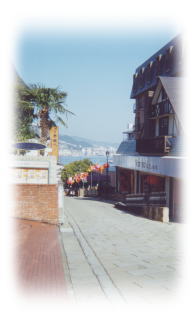
8) Banishment from Japan to Manila
After the battle of Sekigahara, Tokugawa Ieyasu became the ruler of Japan.
The Government intensified its persecution against Christians, and many
Christian feudal lords apostatized or were deported.
In January, 1614, Ieyasu issued edicts proscribing Christianity and banishing missionaries, and ordered Toshinaga, the eldest son of Toshiie, to hand over Ukon and Joan Naito, who were staying in Kaga, to Kyoto Shoshidai. Because the number of Christians increased wherever Ukon went, Ukon's
name was always the first to be mentioned whenever persecution took place.
The Maeda family advised Ukon to apostatize temporarily, but Ukon had already
made up his mind. He thanked them and left for Kyoto. On the way to Kyoto,
assassins lay in wait for him, and hardly a day went by without feeling
danger of his life. Despite his situation, Ukon continually encouraged
others in their faith.
When Ukon and the others arrived in Sakamoto in Shiga prefecture just outside Kyoto, Kyoto Shoshidai did not know what to do because they were supposed to have been killed
before arrival. As the result, they were all set to Nagasaki. About 150
days after they had left Kanazawa, they arrived in Nagasaki, where they
were warmly welcomed by many Christians there. Ieyasu, afraid of Ukon and
his followeres, decided to banish them from Japan and to send them to Philippines.
About 350 Christians, on their way to banishment in various countries,
were on the voyage. The ship was old and it was a long and painful journey.
The cabins were flooded and books and clothing were soaked. However, it
is said Ukon prayed and read books without complaining. On December 11,
the people welcomed Ukon's party to Manila with a gun and infantry salute.
Only 40 days later, Ukon was stricken by his illness. Before being called
to heaven he encouraged the weeping members of his family, saying, "Why
are you weeping? Now God will be your father."
On February 4, 1615, at the age of 63, Ukon's life ended in a Christian
country. He wanted to be a Christian rather than to gain status or honor,
and that was how he lived to the end. He practiced the righteousness of
God, and told many people about the love of God.
These all died in faith, not having received the promises, but having
seen
them afar off were assured of them, embraced them and confessed
that
they were strangers and pilgrims on the earth.
Hebrew
11:13
The footsteps of Joan Naito, Gracia Hosokawa, Ukon Takayama and many other
Christians show us the way for believers even now.


